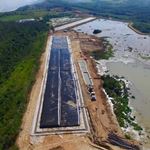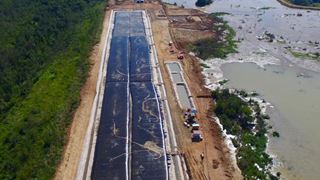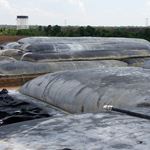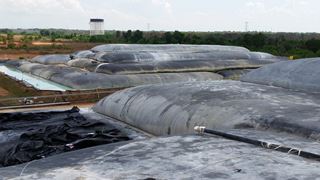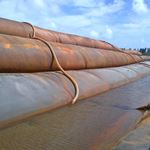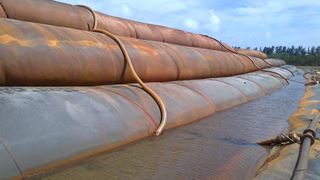Case story
Geotube® Mine Wastewater Management at MMG Gold Mine, Tasmania
Australia, Tasmania
The challenge
The MMG Rosebery mine in Tasmania is a productive, rich underground mining operation that has been producing gold, zinc, copper and lead concentrates for over 80 years. Waste slurry from the process plant is deposited into two tailings dams; a primary, older Tailings Storage Facility (TSF) near maximum capacity plus a newer, smaller one.
Strict environmental regulation restricts discharge of wastewater runoff into the environment. A single discharge point associated with the primary older tailings dam adds complexity to the water management operations of both TSF’s.
Water management regulations required discharge from the new tailings dam to be recycled back and discharged into the older tailings dam, together with contaminated water pumped out of the underground workings. Runoff is then collected and settled in a series of polishing ponds before finally discharging into the environment.
Reliance on a single discharge point means the mine must ensure with certainty that any water discharged complies with governing regulations as any breach risks affecting mine operations.
The solution
To improve water management, a suite of solutions were implemented:
- dewatering and cleaning the downstream polishing ponds
- utilizing TenCate Geotube® units to capture fine contaminants in water pumped up from underground workings
- sediments in higher flows of water was recycled back to the old TSF from the new TSF
Dewatering of polishing ponds
Dewatering and cleaning up the polishing ponds involved establishing a dewatering pad and polymer dosing unit near a fresh water source 600 m away from the furthest pond. The tube pad elevation was 23 m higher than the lowest pond, requiring use of booster pumps to deliver the slurry to the tubes.
The volume of sediment in the ponds was calculated, and three Geotube® GT500D units with a circumference of 36.6 m x length of 30.6 m units were installed.
Slurry dredged from the ponds was dosed with polymer mixed on site. The operation was subject to regular audit by the mine and environmental authorities, and proceeded without incident.
Water management tubes
Setting up and operating the Geotube® units to filter the recycled tailings and underground wastewater was a greater challenge.
The mine is located in the middle of dense forestland and operates within a constrained footprint. The only location large enough to accommodate the Geotube® units was out on the older larger tailings dam. Adding to the complications was a dam wall raising project that required the tubes to be installed on tailings at least 100 m away from the wall (with the tailings varying varying from stiff to very soft).
The first six units of Geotube® were deployed in groups of two, with a gap between each set. Two tube units at a time were then pumped with water containing a very low solids content (0.5%) at 600 l/sec without polymer dosing. Water discharge from the tubes was rapid and clear.
As operations proceeded, it became apparent that the high volume of water discharged was softening the tailings beneath the inner (open dam side) of the tubes more than the outer (wall side) of the tubes, resulting in uneven settlement and the failure of one end seam of one tube with discharge from the seam failure dispersed out towards the center of the dam.
Geotube® units perform at their best when pumped slurry uniformly fills the tubes and evenly tensions the tube fabric. Uneven filling or distorted settlement prevents uniform fabric tensioning and increases the risk of tube failure.
Examination of the failed tube found that there was no settlement down into the tailings at the outer (wall end) and settlement of 750 mm ~ 1 m down into the tailings at the inner (dam side) of the tube. Inspection of the failed tube showed that solids within the intact bulk portion of the tube were well dewatered and firm, indicating good dewatering functionality up to rupture.
As the project proceeded, additional Geotube® units were required to be laid further and further away from the firm tailings against the wall into increasingly soft conditions out in the dam. Access out over the soft tailings was improved by laying bidim™ nonwoven geotextile, and the tube units laid over geomembrane which directed water discharge from the tubes out into the dam, away from the tubes themselves.
In total, 38 large Geotube® units each with a 1,000 m³ sediment capture volume, were deployed, with 32 tubes installed over very soft tailings that was very difficult to access.
The performance
The project has provided MMG and TenCate with a wealth of knowledge in how to successfully install and operate large tubes over extremely soft substrates, and function as a high-volume water management tool, collecting and containing sediments within the confines of the TSF.
It is knowledge that can be applied within the broader industry when land space for installation of Geotube® units is limited.
• By directing the high volume of water discharged from the tubes away from the vicinity of the tube footprint, you can avoid further softening of the tailings below.
• Geotube® settlement is dependent on the strength of the substrate. Providing tube units are uniformly filled and tube fabric evenly stressed as filling progresses, Geotube® units can safely be deployed over soft substrates without undue risk of failure.
• Installation and operation of Geotube® in such challenging conditions should be undertaken by our experienced applicators familiar with Geotube® performance and safety limits.
• The project confirmed the capability of TenCate Geotube® dewatering units to function as high-volume water processing containers that can capture fine particles in suspension.
Our Specialist Installer:
Armstrong Resources Management
Speak to our
dewatering specialists for more information.
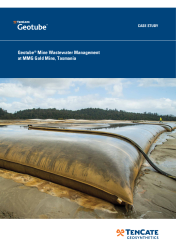
Geotube® Mine Wastewater Management at MMG Gold Mine, Tasmania
TenCate Geotube® units installed over soft tailings
38 large Geotube® units each with a 1000m3 sediment capture volume was deployed
A panoramic view of the Geotube® units
Dewatering of the polishing ponds



